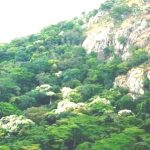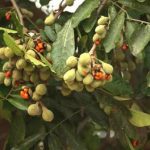TREE LIFE
SEPTEMBER 1981
MASHONALAND CALENDAR
Tuesday September 1st : Botanic Garden Walk. Meet in the Car Park at 1645 for 1700 hours.
Sunday September 6th : Binga Swamp Forest. Come for the morning, the afternoon or bring your lunch and stay for the whole day. Tea and coffee will be provided but please bring cups. At about 1000 hours and 1500 hours Dick Petheram will give a guided walk through the forest and over to the out-rider stream which I don’t believe many have visited and also we will have a walk into the surrounding hills.
Although small, 3.5 hectares, Binga is a real forest of huge riverine trees, ferns and moss, with a foresty atmosphere, in a large swampy vlei surrounded by kopjies with a completely different vegetation. We are lucky to have – and for that matter to still have – a bit of forest so close to Salisbury. To those who have not visited it before you have a treat in store for you and to those who spent time fighting the Mauritius Thorn that invaded and threatened to destroy it come and see how the battle has almost been won. How the forest has been saved from Mauritius thorn makes a fascinating story which Dick will tell during his guided walks. Science News Vol. 13 No. 8 August 1979 and Tree Life No. 15, June 1981 have articles about Binga.
Footnote: The forest is still there despite there having been a recent fire and because by then the vlei grass should be attractively green again. Speaking of the vlei, those people who have gumboots might care to bring them as the area is most satisfactorily wet for this time of the year.
Saturday 19th/Sunday 20th September : Umtali
This trip is still on. Although there have been insufficient bookings to warrant our own bus, Express Motorways have a regular service which leaves Rezende Street Terminus, Salisbury at 0800 hours arriving in Umtali at 11.40 hours on Saturdays and returning Sunday leaving Umtali at 1430 hours. The fare is the same, $15. We have booked 17 seats which is more than are actually required at present so if anyone else would like to join us they will be welcome. I have arranged to hire a car in Umtali to transport us to and from our hotels. All looks set for a super weekend. To recap: Saturday afternoon Cecil Kop Nature Reserve with John and Sandy Burrows. Meet at the Kingsley Fairbridge Memorial 12 noon for 12.15 hours. Saturday evening – at leisure. Sunday morning – Murahwa’s Hill; meet at the entrance next to the Showgrounds at 0930 hours. Make your own arrangements about accommodation, including lunch on both days. If anyone has friends in Umtali who would like to join us they will be most welcome.
BOTANIC GARDEN WALK, 1ST AUGUST 1981
Cheryl Haxen was with us and I would like to thank her for the following account of our visit and also Mr. Tom Muller for leading us in his usual instructive and entertaining way.
In the wake of our successful trip to Wedza Mountain we looked once again at forest, and forest edge species.
A small Strophanthus speciosus was in flower in the gardens. There was great excitement generated by the discovery of this species on Wedza Mountain, its occurrence in Zimbabwe is limited to possibly two small areas. Strophanthus (common name is ‘poison rope) belongs to the family Apocynaceae. The common garden ornamental, oleander also belongs to this family, and it’s extremely poisonous properties are well known. Strophanthus also has a poisonous reputation, the leaves and seeds being used to prepare an arrow poison.
The grape family, Vitaceae, contains several forest species, including Rhoicissus tomentosa and R. rhomboidea. Both are woody climbers of evergreen or riverine forest, and bear small grape like edible fruit. R. tomentosa has a limited distribution in this country, mainly in the Eastern district forests, though it occurs on the Acropolis of Great Zimbabwe. R. rhomboidea has become a popular pot plant in Europe, and here at home, although it grows wild in the Vumba.
Craibia brevicaudata, Family Leguminosae subfamily Papilionoideae, was another species seen on our Wedza Mountain outing, though the appearance of the botanic garden specimens are quite different to the ones we saw growing wild. Out of the forest habitat Craibia forms a rounded tree with branches so close to the ground that the trunk is barely visible. At Wedza Mountain the very long trunks and high canopy had most of us baffled until we noticed the wavy edged leaflets.
Tom Muller pointed out to us the unusual combination by Craibia of a compound leaf with drip leaflet – an apparent coupling of a water conservation adaptation with a moisture eliminating one.
Meg’s mention of the white witch hazel, Trichocladus ellipticus, Family Hamamelidaceae, in the last newsletter led us to the garden specimen yet again. There were still flowers, but these did not seem to have the very potent fragrance reputed to them. Whilst it has flowered heavily several times, it has never set seed. However, Tom has succeeded in propagating further plants by ground layering, a technique by which a branch is bent down and partially buried in earth. If one is lucky, roots arise from the submerged part, and eventually the branch can be cut from the parent plant and the new plant transplanted.
-Cheryl Haxen
SERUI SOURCE – 16TH AUGUST 1981
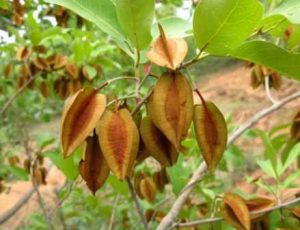
Combretum collinum. Photo: Helen Pickering. Source: Flora of Zimbabwe
Despite the early morning cloud we had a sunny day and despite the diesel crisis we had a bus. Those two factors although not pre-requisite do contribute to the enjoyment of an outing and our trip to Serui Source in the Norton district certainly was most enjoyable. Mr Ralph Palmer has been preserving the trees there for 48 years – the length of time he has lived and farmed there. Paul and I had only done a brief ‘recce’, as a result the first two trees we looked at were unidentified, the first with almost round leaves glabrous above and very velvety on the under surface, the second had ovate leaves without hairs on either surface. We were satisfied that both, with their opposite leaves, were Combretums and by the end of the day had decided that both were in fact the Variable Combretum Combretum collinum. (Mr Bob Drummond has since confirmed this). Despite an exhaustive search no fruit were found. Later our discussion centred round another tree we thought could also be a Combretum and one of our guests found fruit on the ground which he picked up and showed to the nearest member, who grabbed it, shouted ‘Meg’ and disappeared in my direction. Our guest really did want to examine it and know what that interesting 4-winged fruit was. It had to be C. collinum as it was too small to be the large fruited Combretum Combretum zeyheri and too big to be anything else. Mr. Drummond has also confirmed that the very spiny shrub we saw was Duranta repens, an introduced garden ornamental from South America. As a result of its fruit being so popular with birds it is now widespread in Zimbabwe. In this country there are only two genera in the family Ebenaceae, Euclea and Diospyros and although I have seen Diospyros mespiliformis, the ebony Diospyros, previously on several occasions I have not yet “clicked” so having assured everyone that what we were looking at was Euclea divinorum I was considerably deflated when Trevor Gordon arrived and said, “this is Diospyros mespiliformis, no doubt about it at all”. It did have the growing tip characteristic of Diospyros, so I have absolutely no excuse.
My second bad mistake of the day was in a hand-out I had prepared and distributed where I included Euclea divinorum, Diamond-leaved Euclea in the group having alternate leaves, although I did say they could be sub-opposite. On Sunday I was shown how the distinguishing feature between E. divinorum and E. natalensis was that the former has opposite to sub-opposite leaves and in the latter they are alternate. It was not my day for Ebenaceae. The large-leaved Euclea Euclea natalensis were lovely, much cleaner looking than usual and in full flower smelling sweetly and humming with bees as were E. divinorum. Other species in flower were the Red-hot poker tree Erythrina abyssinica and the Winter Cassia, Cassia singueana, both later than usual this year and, with its insignificant flowers in great profusion was Rhus longipes, the large-leaved Rhus. This species is the saviour of Tree Society August outings when nearly everything else is bare or nearly so, as its apple green leaves are the first to defy the frost and show signs of the coming spring. On this occasion in addition to its scented profusion of flower there were even trees with ripening fruit. Not in flower unfortunately and typically growing on an anthill was Schotia brachypetala, weeping Schotia. It was only after discussion that we decided it was Schotia and not Schrebera alata, wing-leaved wooden pear, both have compound leaves and both have a winged rachis, but Schotia has more leaflets – 4 to 6 pairs and is paripinnate (ie has pair of leaflets at the end) while Schrebera alata has only 1 – 2 pairs of leaflets plus a terminal leaflet (ie imparipinnate). On the same anthill was Ehretia obtusifolia and nearby Maytenus senegalensis, confetti trees, with unusually tree-like proportions. One of the most dramatic sights of the day were a number of strangler figs, on this occasion Ficus burkei with their young aerial roots hanging from the trunk and branches illustrating how the process of becoming a strangler could have started. Are all figs potential stranglers and/or rock splitters and is it purely coincidence of where they start their existence that determines what they will become?
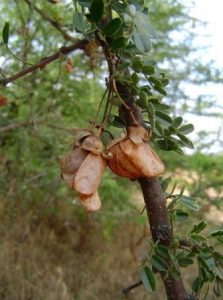
Ormocarpum kirkii . Photo: Bart Wursten. Source: Flora of Zimbabwe
The surprise of the day were the presence of Osyris lanceolata, Ormocarpum kirkii and Kigelia africana, all of which I think we could have expected to find in different localities. The bark bush Osyris lanceolata is usually described as a shrub but there was no doubt about the tree like habit and size of this particular specimen which was in flower, aptly described as inconspicuous. What was conspicuous was the blue-green bloom on the leaves, the apex of which has a short sharp point. The Ormocarpum kirkii were in a little group, mostly completely leafless but all in pod, obviously last seasons as it usually flowers at the end of the rains. The common name curled caterpillar pod comes from the fact that their hairy pods look just like little caterpillars curled up inside the dried remains of the flower. The sausages of Kigelia africana – also with an appropriate common name, the Sausage Tree, were lying on the ground underneath so if anyone had any doubts about its identity this, coupled with its characteristically hard harsh compound leaves, these doubts were soon dispelled. Also an unusual occurrence were Msasas Brachystegia spiciformis with their pods at the top of the tree. Everyone knows that Mnondo has pods on the top of the tree and the Msasas are borne amongst the leaves! However, the pods of the Mnondo Julbernardia globiflora are velvety so there is no doubt about the identification of the smooth pods as being those of the Msasa.
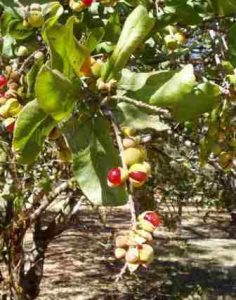
Pappea capensis. Photo: Mark Hyde. Source: Flora of Zimbabwe
The ultimate point of our morning walk was an anthill below the dam where we found Pappea capensis, the Indaba Tree with its seedlings all round about and a huge Mimusops zeyheri, common red-milk wood. Fortunately it had a bit of low coppice growth so that we were able to see that it has a milky latex. These are the trees which grow in the temple at the Zimbabwe ruins.
After lunch we went by bus to another part of the farm to meet the daddy of them all, a giant Sycamore Fig, Ficus sycomorus and when we arrived there was a Spotted Eagle Owl sitting on a branch wondering why his slumber had been disturbed. After we all had a chance to admire him he flew off and we turned our attention back to the tree which really is enormous. Its trunk has a circumference of 7.5m, put simply it would take 5 people with arms outstretched to circle it. 5 large and 8 lateral branches arise from fairly low down all of which form a canopy with a diameter of 33m over 100 ft – the whole resembling a marquee. This species is the Sycamore Tree of the Bible and although this particular specimen obviously was not as old as that Trevor Gordon estimated its age to be at least 200 years.
Our surprises for the day still were not over, we found. A Faurea saligna with an 18” diameter trunk and its crown well above the surrounding trees looking most “gum tree” like. Many of the species we found in the afternoon differed markedly from those we had seen in the morning. One wonders why? It may be that the area we explored in the morning was less well drained and it has been suggested that the presence of Acacia rehmanniana which was plentiful in the morning is an indication of badly drained soil. Certainly, looking back on the two areas, I can think of no other reason why they should be so different – unless it was just to add to our enjoyment. Thank you Ralph Palmer and Ann and Jim Sinclair for your warm welcome, for sharing your trees with us and for sharing our enjoyment of them.
-Meg Coates Palgrave
MAKABUSI WOODLANDS
The first Nature Trail has been laid out and was named the Douglas Aylen Trail on 25th July by Mrs. Sally Aylen. At the same time she handed a cheque for $300 to the Makabusi Woodlands Association on behalf of the Tree Society in memory of Douglas. Perhaps now that some development has actually taken place the momentum will continue. The following is a summary by Paul of a circular concerning the next stage : –
The Mashonaland Branch of the Wildlife Society has accepted responsibility for the ‘Wild Zone’ of the Makabusi Woodlands. This is not to be a zoo or an orphanage but it will be a fenced area scientifically planned and stocked with indigenous animals, and it is hoped that the first will be introduced in December.
The concept of this project is to have trained guides to conduct foot safaris through the area at weekends; guides who can give a meaningful and stimulating commentary, not only on the game seen but also on the plants, trees, insects, etc. to be found at that particular time.
Is that not a challenge? Would you like to be one of these expert guides? The ranger leading a safari? To learn a lot yourself and then, most stimulating and valuable of all, to make others, particularly schoolchildren, interested in wildlife and its conservation?
It is not difficult. Training courses to become one of these guides/rangers are to be held at the University of Zimbabwe, on Thursday each week at 7.30pm to 9.30pm for fourteen weeks from 10th September to 10th December and field trips also will be arranged at weekends. Each participant must undertake to give of their time – 2 hours at a weekend once a month.
Application forms are available from the Monomatapa Wildlife Shop, Box 3497, Salisbury, telephone 7004351.
Footnote : I think this is an appropriate place for the following : “a great many people consider the New Education “go and find out” based on the Environment to be a gimmick. If you have friends who believe this bring them to outings. Tell the half convinced the anecdotes that in America Buildings by the ‘nouveau riche’ of places where they spoil the scenery is called “Californication” and Destruction of a haven of Nature (ecosystem) for monetary gain is called “Ecopornoraphy” These words have impact.
MATABELELAND CALENDAR
Sunday September 6th : Please note change of date of field meeting; owing to the Wild Life Society Game Count being held on 12th we have reverted to the first Sunday, and cannot have our joint meeting with the OAZ. Meet at 0830 hours at Retreat Shopping Centre, bringing lunch and cool drink which can be carried with you; we intend going to the Brachystegia Woodland in the Mtsheleli Valley of Rhodes Matopos National Park; there should be some spring foliage by then and interesting bird parties searching for insects.
Sunday October 4th : To the kopje area of Rhodes Matopos National Park, site of proposed Wild Life College to complete listing of tree species. Meet at Retreat Shopping Centre at 0830 hours.
I am delighted to include the following notes from Miss Janet Webber about the Matabeleland Branch activities :
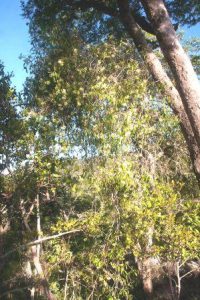
Tarenna neurophylla. Photo: Mark Hyde. Source: Flora of Zimbabwe
The Matabeleland Branch had a great time listing the woody vegetation on the kopjes at the site of the proposed Wild Life College at the entrance to the Rhodes Matopos National Park. This was quite a challenge as Matabeleland trees are frequently leafless in August, but we were grateful for such evergreen trees as Strychnos, Rhus, Mimusops and Tarenna. We went in twos over the rocky outcrops and listed close on 100 species by lunch time. There is a ring of kopjes some impressive, some misleading, being low at the eastern approach and falling steeply away to the west. There were some very fine specimens, notably of Kirkia acuminata and Ozoroa insignis. Maytenus senegalensis had finished blooming and others were flowering or in bud, i.e. Turraea nilotica, Commiphora schimperi and Tarenna neurophylla.
It was a privilege to undertake this, and there is always something more needed, in this instance to collect grasses! We saw interesting signs of animals, old spoor of leopard, porcupine and not so old spoor of White Rhino. The latter was so very large that with our eyes on the tops of kopjes we nearly fell flat on it!
OPENING OF TSHABALALA GAME SANCTUARY
On Friday, 7th August the Prime Minister officially opened this game sanctuary which is on the outskirts of Bulawayo. He spoke extremely well on the subject of “conservation and a rationalised use of our natural environment. “ and Senator Msika, Minister of Natural Resources and Water Development had positive opinion to put forward.
This game sanctuary will allow people to go on foot for game viewing and it has the distinction of being the only park which is wholly acacia woodland. The three metres high black gates at the entrance have outlines of buck, zebra and ostrich in white wrought iron, a gift from a local businessman, and they are a very fine pair of gates. This is one of many instances of voluntary work and donations. The Wild Life Society has done a great deal towards helping Government establish this park.
It was a privilege to represent the local branch of the Tree Society at the opening. Members had done some very good work on plant collecting and listing of tree species.
-J.I.Webber
THE COMMITTEE
After 2.5 years as a valuable member of the committee, Anton Ellert has resigned as he is moving to Ruwa to grow asparagus. Our very best wishes to with you Anton and we hope that you will find time for Tree growing too.
Mr. Brian Best who has recently transferred from Bulawayo has agreed to be co-opted on to the committee. Welcome Brian.
If anyone who lives out of Salisbury would like to join one of our outings and requires accommodation either before or after the trip Paul and I would be delighted to offer hospitality for the weekend.
-MEG COATES PALGRAVE, CHAIRPERSON


